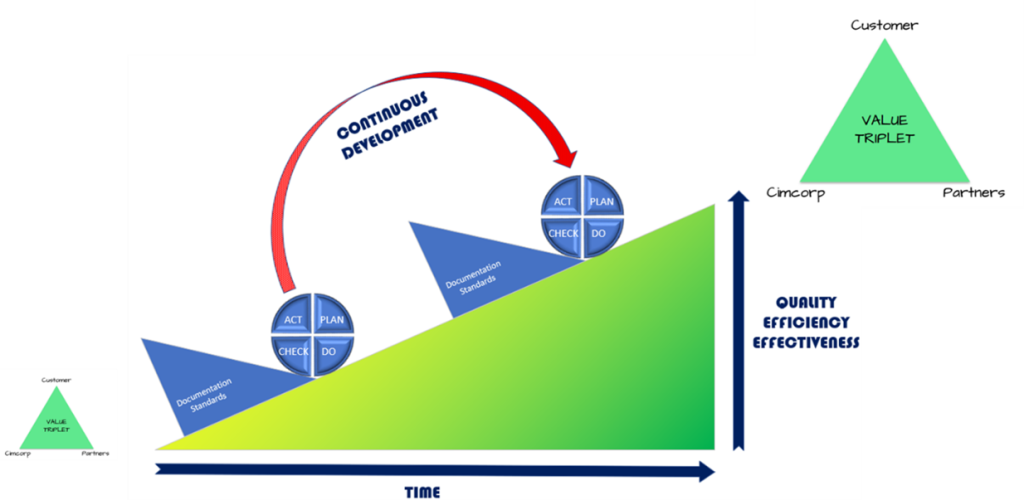
All you need is Trust
Trust and strong collaboration among project participants are fundamental for the success of an alliance project. Project alliancing cannot be used in any industry with the wrong type of people or wrong type of organisations: If you cannot build trust and open collaboration, you should not make alliancing contracts.
Introduction of Project Alliancing
In recent years Alliance-based project models have been successful, rewarded, and recommended project model for especially big and mega-sized construction projects.
The first alliance project in Finland, the Lielahti–Kokemäki railway project, was completed in 2015. Since then, alliances have been successfully utilized as the implementation model in dozens of projects, such as hospital and infrastructure projects. In short, the alliance model means that the project parties – the customer and service providers – create a joint organisation, contract, and objectives and work together, sharing all the risks and benefits. (YIT, 2023.)
Ask AI!
If an organisation needs to develop a new project model, what would it be like? Depends on the size and type of organisation of course. But if the organisation is fairly big and the projects are complex, the first research method would be for instance an OpenAI query with a question: Introduce the best project model for a complex project. Guess what? You will find Integrated project delivery and project alliancing at the top of the list.
Then ask AI about the visualization of the alliance project’s ”big room,” showcasing the collaborative atmosphere, digital screens, and experts at the central table. You will find the collaborative aspect of alliance contracts. An AI-drawn picture is on top of the article.
Excellent Project Alliance
The Thesis ”Excellent Project Alliance” by Stenfors (2024) found many distinct aspects of alliance and IPD-based models and the use of cases all over the world. Understanding is also clear what elements could be implemented in the project model and piloted in the automation industry company Cimcorp Oy. Alliance and IPD-based models align the parties to common goals, fostering innovation, collaboration, and communication and encourages trust-building behavior in projects.
Additionally, the Thesis focused research on the project standards, mainly IPMA-based, to be implemented in the Modus pilot project model in different types and sized projects.
The pilot product is structured mainly according to the IPMA Project Excellence model, where People and purpose, Processes and resources, and project results are in harmony with each other. This is like a chair with three legs.
The challenges of the Excellent Project Alliance?
When researching the challenges and failures of Alliance projects and contracting, a few issues were raised above others.
- Trust and strong collaboration among project participants are fundamental for the success of an alliance.
- Organizations with limited experience in project delivery or a weak history in relationship contracting may face challenges with the alliance model unless they bring in an experienced professional to manage their role effectively.
- A significant challenge for clients in an alliance setup is achieving value for money throughout the project. Companies with ongoing partnerships must establish and regularly review benchmarks to ensure the alliance fosters continuous development and aligns with best practices.
I am not arguing, that project alliancing will fail without continuous development, but surely the justification of ”Value for Money” is more difficult without a benchmark and continuous development process. In the Modus pilot model, the process was planned to visualize the growth of Cimcorp Value Triplet.

Lack of trust
I have always believed in the power of good relationships between partners, suppliers, and the customer. Sincere caring for each other in the project will build trust and commitment.
Australian Government (2015) states, that an alliance is established by the Owner to deliver the project’s approved capital and/or service objectives at a fair cost. It is useful to consider the successful establishment of the alliance as dependent upon the alliance’s success factors.
- Good faith & Integrity
- Transparency
- No fault No blame
- No disputes
- Risk and opportunity sharing
- Joint management
- “Best for project”
Referring to the success factors, what if you don’t have trust and commitment in the project?
- You will not have Good faith & Integrity in the project, you are not transparent
- Fails will be someone’s fault and you will blame for it so there will be disputes
- You are not sharing the risks and opportunities, so lack of joint management eventually turns into “Worst for project”, instead of ”Best for project”
I have always believed in the power of good relationships between partners, suppliers and the customer. Sincere caring of each other in project will build trust and commitment.
How can Project Excellence be integrated in the alliance model?
The IPMA Project Excellence Model can be drawn in the project management handbook and interfering handbooks in the Quality management system. IPMA Project Excellence Baseline has been written by many top project management experts and influencers around the world. They have strong experience with the alliance model as well and IPME PEB is also referring to the possibilities to use alliancing methods.
That said, PEB is quite a demanding model, especially for the management level. Many could feel the model laborious and even costly. You cannot measure advantages by money, at least at the very beginning of PEM integration in your management system.
Conclusion
The key findings from the pilot indicated that the Alliance-based project model can also be implemented in automation industry projects as well as programme management, provided that the methods are developed and documented in the company’s quality management system. Additionally, these methods should be detailed in the Project, Programme, and Portfolio Handbook. Implementing such changes requires adjustments to the organisation’s structure and the introduction of additional support functions.
This model and pilot product could not be productized right away. It may need some testing in real conditions first. Therefore, I am glad that I found solid ground for testing this in Cimcorp.
Trust is all you need.
References
- Australian Government. (2015). National alliance contracting guidelines guide to alliance contracting September 2015. Australian Government. https://urly.fi/3HJa
- OpenAI. (2023). ChatGPT (Mar 14 version) [Large language model]. https://chat.openai.com/chat
- Stenfors, J. (2024). Excellent project alliance [Master Thesis, Turku University of Applied Sciences]. Theseus. https://urn.fi/URN:NBN:fi:amk-2024121837236
- YIT. (2023). A successful construction project starts by choosing the right implementation model. YIT. Retrieved December 13, 2024 from https://www.yit.fi/en/projectmodels